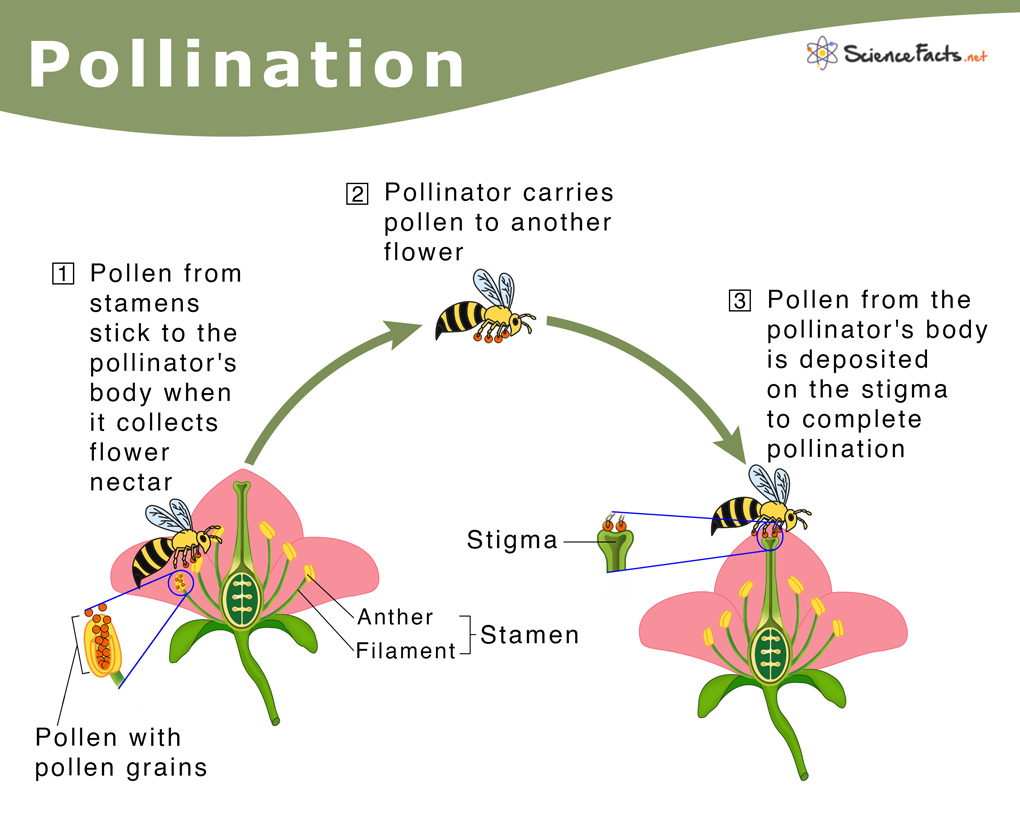The act of transferring pollen from the anther, the male part of a flower, to the stigma, the female part, is called pollination. For pollination to occur, the plants must be of the same species.
How does Pollination Work: Steps of Pollination
Agents of Pollination: Pollinators
Types of Pollination
Why is Pollination Important
Step 1: The first step is to transfer pollen from the anther to the stigma of the same or different flower. Step 2: After the pollen’s successful transfer, a pollen tube starts forming along the length of the style. The style is a long stalk that connects the stigma to the ovary of the flower. Step 3: After the pollen tube is complete, the sperm cells travel through it to reach the ovary. The union of the sperm and egg cells in the ovary results in the formation of a seed. Step 3: Finally, the seed gets detached from the parent plant, and their dispersal causes a new plant to grow. The new plant participates in pollination to repeat the cycle.
1) Biotic
Pollination by Animals (Zoophily)
Various factors such as the flower’s scent, the nectar’s position, and the pollen’s nature are essential for zoophily. They are of three types:
Pollination by Insects (Entomophily): Colorful, fragrant flowers such as sunflower and orchids attract pollinators such as bees, wasps, ants, beetles, moths, butterflies, and flies. Insects also pollinate aquatic plants such as water hyacinth and lily.Pollination by Birds (Ornithophily): Flowers having copious nectar and red petals such as orchids and wildflowers are pollinated by hummingbirds and sunbirds.Pollination by Bats (Chiropterophily): White petal flowers with a strong scent that flowers at night, such as java and bauhinia plants.
2) Abiotic
Pollination by Wind (Anemophily)
This type of pollination is observed in forests where the air carries pollen from one tree to another. It can also occur within the same tree. Anemophily is more effective for flowers with free-swinging, light anthers to be carried easily by the wind. Coconut, palm, and maize are some examples of wind-pollinated plants.
Pollination by Water (Hydrophily)
This type of pollination is widespread in plants such as algae, pteridophytes, and bryophytes. They have a mucilaginous covering that protects the pollen grains.
1) Self-Pollination
Transferring pollen from the anther to the stigma of the same flower is called self-pollination. It is the primary type of pollination in plants. Self-pollination is common in plants that contain both male and female sexual parts in the same flower. Beans, peas, lettuce, tomatoes, peppers, and eggplants are examples of self-pollinating plants. Self-pollinating plants depend less on external factors for their pollination. They depend on wind and other smaller insects for their pollination. Self-pollination can be of two types: a) Autogamy: Transferring pollen from the anther to the stigma of the same flower. b) Geitonogamy: Transferring pollen from the anther of one flower to the stigma of another flower, but on the same plant.
Advantages
Maintains the purity of the race as there is no mix up of genesSimple and fast processHigh rate of successful pollinationLess dependent on external factors such as wind, water, and other pollinating agents to cause pollinationLess wastage of pollen grainsEnsures that the fewer dominant characters are eliminated, and only the dominant characters are expressed
Disadvantages
Involves no mixing up of genes, and thus new characters or traits are not incorporatedCauses a decrease in the vigor and vitality of the raceOffspring are borne with less immunity and thus are more prone to diseases
2) Cross-Pollination
Transferring pollen grain from the anther of one flower to the stigma of another flower is called cross-pollination. This type of pollination is complex, involving flowers that are genetically different from each other. Grasses, daffodils, pumpkins, and apples are examples of cross-pollinating plants. Cross-pollination always depends on another agent for pollination to occur. The agent can be biotic such as bees, birds, insects, and animals or abiotic such as wind and water. Cross-pollination, when done artificially by humans, is called artificial pollination. This process is utilized to overcome external difficulties in pollination, increase the yield of crops, and introduce some new traits or characters in the plant.
Advantages
Introduces new traits that are of good vigor and vitalityImproves immunity against diseases and also to the changing environmentEliminates the recessive and nonessential characters Reproduces in unisexual plants
Disadvantages
Massive wastage of pollen grainsChances of elimination of good qualities and incorporation of nonessential characteristics in the offspring
Cleaning up the environment by producing oxygen and reducing the carbon dioxide level of the atmosphere.Purifying the rainwater before reaching the water table.Preventing soil erosion.
Economic Importance
Helps in the production of food, medicines, fibers, oils, resins, latex, gums, tannins, soaps, waxes, and plant-based dyes.
